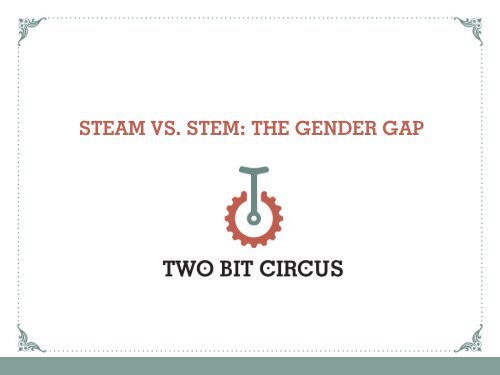STEAM VS STEM THE GENDER GAP
2BC_STEAM_report
2BC_STEAM_report
Create successful ePaper yourself
Turn your PDF publications into a flip-book with our unique Google optimized e-Paper software.
<strong>STEAM</strong> <strong>VS</strong>. <strong>STEM</strong>: <strong>THE</strong> <strong>GENDER</strong> <strong>GAP</strong>
Although general awareness of the acronym <strong>STEM</strong> - science, technology, engineering, math - has increased<br />
in recent years, there has been debate around a few more notable <strong>STEM</strong> topics, such as the awareness of <strong>STEM</strong><br />
programs, activities, and toys, and the gender gap in <strong>STEM</strong>. To explore these topics further Two Bit Circus surveyed 500<br />
parents with kids between the ages of 6-14 years-old about their child’s interest in <strong>STEM</strong>.<br />
Findings reveal a strong lack of awareness of <strong>STEM</strong> extracurricular activities and toys. In fact, nearly half of<br />
parents (47%) are not entirely familiar with <strong>STEM</strong> toys. Data also uncovered a significant gender gap that exists in<br />
<strong>STEM</strong>, with most male children expressing interest in <strong>STEM</strong> topics outside of the classroom, while their female peers do<br />
not carry the same interest in those activities externally.<br />
As a company that wants to inspire young thinkers through curiosity and innovation, our main goal is to encourage<br />
every child to embrace <strong>STEM</strong>. We have found that <strong>STEAM</strong> is a great way to welcome all young students of both<br />
genders, as <strong>STEAM</strong> incorporates the additional (and critical) subject matter of art. Survey insights confirmed that art is,<br />
in fact, the way to capture girls’ interest as the entry point to <strong>STEM</strong>.<br />
IN <strong>THE</strong> FOLLOWING PAGES WE WILL EXPLORE:<br />
The lack of awareness around <strong>STEM</strong><br />
The gender gap of <strong>STEM</strong><br />
The ability for Art to be an entry point to <strong>STEM</strong>
<strong>THE</strong> LACK OF AWARENESS AROUND <strong>STEM</strong><br />
The term <strong>STEM</strong> is popular especially in the<br />
educational space. However, many parents<br />
are not familiar with the benefits of <strong>STEM</strong> as<br />
a whole. Sure, parents are familiar with the<br />
subject matter that collectively describes this<br />
acronym, but the lack of awareness around<br />
extracurricular activities and toys in this area is<br />
somewhat alarming.<br />
Nearly half (47%) of parents are not familiar with<br />
<strong>STEM</strong>/<strong>STEAM</strong> toys
<strong>STEM</strong>/<strong>STEAM</strong> IN SCHOOL AND AT PLAY<br />
62% of parents say that their<br />
child never participates in<br />
<strong>STEM</strong>/<strong>STEAM</strong> extracurricular<br />
activities outside of school<br />
37% of parents are not<br />
familiar with <strong>STEM</strong>/<strong>STEAM</strong><br />
extracurricular activities<br />
outside of school<br />
2 out of 3 parents say that their child<br />
does not have <strong>STEM</strong>/<strong>STEAM</strong> toys
WHAT WE LEARNED:<br />
Although parents are familiar with the subjects that combine together to create<br />
<strong>STEM</strong> - science, technology, engineering, and mathematics - few parents are<br />
aware of extracurricular activities and toys that help reinforce these topics.<br />
Inspiration and curiosity doesn’t vanish when school is over, so why aren’t<br />
more parents aware of after school activities that foster <strong>STEM</strong>/<strong>STEAM</strong> learning?<br />
For the broader <strong>STEM</strong>/<strong>STEAM</strong> movement, this general lack of awareness and<br />
engagement in <strong>STEM</strong>/<strong>STEAM</strong>-based activities points to a clear awareness<br />
problem, and a need for further exploration on the issue.
<strong>THE</strong> <strong>GENDER</strong> <strong>GAP</strong> IN <strong>STEM</strong><br />
The general awareness problem in <strong>STEM</strong>/<strong>STEAM</strong> trickles down further to show a<br />
clear gender gap between <strong>STEM</strong> and <strong>STEAM</strong> subject matter, topics and activities in<br />
and out of school.<br />
While parents of both male and female children equally report that their child’s<br />
favorite <strong>STEAM</strong> subject in school is either math (26% for both genders) or science<br />
(30% for both genders), the gender gap between the reports from parents regarding<br />
art and technology is extreme.<br />
<strong>STEAM</strong>: <strong>THE</strong> INTEREST BREAKDOWN<br />
ART<br />
TECHNOLOGY<br />
13% of boys<br />
35% of girls<br />
35% of parents of girls report art as their favorite<br />
subject, but only 13% of parents of boys report art as<br />
their favorite subject in school<br />
7% of girls<br />
23% of boys<br />
Compare this with technology where only 7% of parents<br />
of girls report technology as their child’s favorite subject<br />
compared with 23% of parents of boys reporting<br />
technology as their child’s favorite subject in school
EQUAL PLAYING FIELD? IN SCHOOL VERSUS<br />
OUTSIDE OF SCHOOL<br />
For many students, their interests at school vary greatly from their interests outside<br />
of school. This is no surprise. However, it is hard to ignore the difference between<br />
each of the <strong>STEM</strong>/<strong>STEAM</strong> subjects.<br />
SCIENCE<br />
TECHNOLOGY<br />
30% of parents report this is their<br />
child’s favorite subject in school<br />
17% of parents report their child<br />
shows the most interest in this subject<br />
outside of school<br />
5% of parents report this is their child’s<br />
favorite subject in school<br />
29% of parents report their child<br />
shows the most interest in this<br />
subject outside of school<br />
ART<br />
MA<strong>THE</strong>MATICS<br />
24% of parents report this is their<br />
child’s favorite subject in school<br />
28% of parents report their child<br />
shows the most interest in this<br />
subject outside of school<br />
26% of parents report this is their<br />
child’s favorite subject in school<br />
6% of parents report their child shows the<br />
most interest in this subject outside<br />
of school<br />
ENGINEERING<br />
5% of parents report this is their child’s<br />
favorite subject in school<br />
6% of parents report their child shows<br />
the most interest in this subject outside<br />
of school
<strong>THE</strong> GREAT DIVIDE: ART & TECHNOLOGY<br />
The <strong>STEM</strong>/<strong>STEAM</strong> interest shows most clearly when you look at it from a gender<br />
perspective. Looking at it from both inside and outside of school, art weighs in<br />
heavily with girls and technology tips the scales for boys.
TECHNOLOGY/<br />
COMPUTING<br />
41% of parents with<br />
boys report their<br />
18% of parents with<br />
daughters report<br />
child is most<br />
their child loves<br />
interested in<br />
technology<br />
technology in<br />
outside of school<br />
school<br />
7% of parents with<br />
girls report their<br />
child is most<br />
interested in<br />
technology in<br />
school<br />
23% of parents with<br />
boys report<br />
their child loves<br />
technology<br />
outside of school
ART<br />
35% daughters favorite<br />
subject<br />
13% sons favorite<br />
subject<br />
45% of daughters show most<br />
interest out of school<br />
10% of sons show most<br />
interest out of school
WHAT WE LEARNED:<br />
This shows us that technology/art are the battleground subjects for exposing<br />
the gender gap in <strong>STEM</strong>/<strong>STEAM</strong>. There is a surprising gender neutrality balance<br />
in Science/Math interests from both both boys and girls in school.<br />
How are these kids’ interests not translating between educational interests<br />
in school which represent the “S” and the “M” in <strong>STEAM</strong>, and continuing on into<br />
what they enjoy doing for fun? (Girl scientist and mathematicians are not the<br />
stereotype!)<br />
Yet, the gender difference between art and technology interests both inside<br />
and outside of school demonstrates where the <strong>STEM</strong> fallout for girls happens,<br />
pointing directly to the “A”, or art.”
GETTING AN “A”: ART IS <strong>THE</strong><br />
DOOR TO <strong>STEM</strong> FOR GIRLS<br />
With the more newly developed acronym, <strong>STEAM</strong>, young<br />
girls are provided with the opportunity to explore <strong>STEM</strong><br />
activities through an artistic, creative gateway they are more<br />
familiar with and enjoy doing both in and outside<br />
of school - art.<br />
GETTING CREATIVE WITH <strong>THE</strong> “ART” OF <strong>STEM</strong><br />
99% of parents with daughters say<br />
their child decides to do some form<br />
of arts & crafts on their own<br />
95% of parents with daughters agree<br />
their child enjoys playing with toys<br />
that allow them to be artistic<br />
and creative<br />
9 out of 10 parents with daughters agree<br />
that their child enjoys participating in art<br />
lessons in school
GIRLS EMBRACE ART<br />
3.5x<br />
Parents with daughters are 63% more<br />
likely than parents with sons to state<br />
that art is their child’s<br />
Parents with daughters are 3.5x more likely<br />
than parents with sons to report that their child<br />
shows the most interest in art outside of school
WHAT WE LEARNED:<br />
Parents with daughters have confirmed through the data that art is the way to<br />
tap their daughter’s interest, especially when coupled with <strong>STEM</strong>. Whether they are<br />
in school or outside of school, daughters are generally engaged by art programs<br />
and activities. By incorporating this subject into the already established <strong>STEM</strong>, the<br />
likelihood of girls expressing interest in these topics they are often uninterested in<br />
after leaving the classroom, increases. Art can serve as the gateway to <strong>STEM</strong> for<br />
girls.
Exploring <strong>STEM</strong> and <strong>STEAM</strong>, we uncovered a huge<br />
awareness issue and a gender gap in interests and its<br />
possible impact on <strong>STEM</strong> engagement for girls. In order to<br />
engage girls in <strong>STEM</strong>, we need <strong>STEAM</strong>. Art must be a part<br />
of <strong>STEM</strong> both inside and outside of school. <strong>STEAM</strong>-based<br />
extracurricular activities and toys are needed, and in order<br />
to drive a gender balanced future of inspired learners and<br />
creative thinkers, ART has to be a part of the equation.<br />
KEY TAKEAWAYS:<br />
LACK OF AWARENESS AROUND <strong>STEM</strong> - Although the<br />
components of <strong>STEM</strong>, science, technology, engineering<br />
and math, are well known, and many are familiar with<br />
this recently developed term, awareness around <strong>STEM</strong><br />
extracurricular activities and toys are extremely low.<br />
<strong>GENDER</strong> <strong>GAP</strong> IN <strong>STEM</strong> - While we knew that technology<br />
has a gender gap, girls and boys are both equally<br />
interested in science and math in school. But while that<br />
awesome interest holds in school, it does not translate<br />
to extracurricular programs or home activities. These<br />
translations from school interests to extracurricular activities<br />
is bridged by the creative “a” for art.<br />
ART IS <strong>THE</strong> ENTRY POINT TO <strong>STEM</strong> FOR GIRLS - The<br />
survey revealed that girls show a greater interest in art than<br />
most <strong>STEM</strong> subjects. In order to increase the amount of girls<br />
interested in <strong>STEM</strong>, we need to embrace the newly coined<br />
<strong>STEAM</strong>, which combines art with the <strong>STEM</strong> subject lineup.<br />
METHODOLOGY:<br />
Two Bit Circus surveyed 500 parents with kids between the<br />
ages of 6-14 years old in October 2016. This survey was<br />
completed online and responses were random, voluntary<br />
and completely anonymous.




